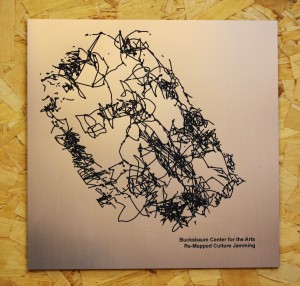Don’t trust all the maps that you see in ARH, Burling and Noyce—they may disorient you. Professor Andrew Kaufman, Art, had his students create ‘re-maps’ of these academic buildings during his 2009 Tutorial on culture jamming. Kaufman spoke with the S&B’s Carl Sessions about this project, artistic expression, and culture jamming as way to assert autonomy.
Tell me about the remapping project and the tutorial you had on culture jamming in 2009.
The tutorial I had in 2009 was called Culture Jamming. I also teach a culture jamming class right now—slightly different texts—but the same premise. We’re learning about global justice and corporations and things that we can do to not feel like we’re hopelessly entangled…to give us some power back. One of the first assignments we did in class was to get in pairs and go into a space. One of the students was blindfolded and the other was supposed to not let any harm come to the other student, and lead them in any manner. The person who was blindfolded had to try to translate back to the student what they heard or what they felt under their feet [by drawing some sort of] line. We talked about that with the term ‘synesthesia,’ the connection of different senses together. It was really about touch—getting them to interact with each other in ways that the U.S. culture doesn’t allow for. It was also about understanding that you are creating a spectacle. The poetic ideal we’re left with is to consider how we move through space through the world in different ways.

The lines look like squiggles. How did the students construct them? Were they random?
Each person handled it differently. You can imagine being a first-semester student and being confronted by the idea of trying to draw something so unusual. I didn’t tell them to draw a representation of an actual wall, I’m trying to tell them to draw an experience. That’s very abstract. You have to make some decisions, and I think of art-making as making decisions…some of them did map out a more traditional idea, and some translated other things. Here’s what happened: after they finished making them they came back and looked at them, squiggles all over the paper, basically, and they’re able to point to instances. They’re able to say ‘oh, this is where someone ran up to us and asked us what we were doing,’ or ‘a biker came by here.’ It becomes a poetic experience. You don’t expect viewers to understand, they’re left with mostly wonder. It doesn’t look like the rotunda of Bucksbaum or a map of Burling.
But that’s precisely the point, right?
Yeah, exactly, for people to wonder.
What does culture jamming look like when done on a larger scale?
It can be simple as graffiti. I think that’s the most common type of expression. It can be beautiful or horrible. But it’s an expression of someone’s life in the world.
Culture jamming intersects with entertainment, Improv. Everywhere is a group that’s on the forefront of this. They do the pant-less subway rides. But if you look at their website they have fantastic commentary. You [also] get people like Reverend Billy, who came to Grinnell last year.
What I’m seeing more and more is the use of Twitter and Facebook to facilitate these things that would have taken a longer amount of time. You can get a lot of bodies into a space to create certain difficulties.
What about culture jamming interests you?
The book that we’re reading in my course is filled with things that make you sad. It’s talking about corporations, the things that you buy and how they affect people far away in other countries. It’s about this power dynamic in which we feel powerless. The great thing about this idea of culture jamming, or any kind of activism, is that you take some of that power back. You say that ‘yes, I do participate in this, but I’m not going to go without expressing myself in some sort of way.’ What’s wonderful about this kind of expression is that when one person does it, it unleashes a flood—you see this at Occupy and these different movements that seem like it’s just a lone voice in the night and all of a sudden it becomes this beautiful force. This is a tool to bring power back away from the corporations.
Do you see any limits to the effectiveness of culture jamming?
There certainly are. It’s really dependent on the media getting it out there. It’s just a matter of who is aware of it. Like anything else, there is information out there and you have to be aware of it. We have to involve ourselves if we’re going to somehow affect change.
What new projects are you working on?
In terms of my own personal research, not too much. But in my class the students have split into groups and are researching different brands on campus to see where they are made and their impact. I’m very interested to see the results of this research later in the semester. Some students are interested in where are food comes from with Sysco. A group is interested in Under Armor to see what’s going on with that, where it’s from, do we have a deal with them. Apple is another one. We’re questioning our links to them.




























































